Drop-Shot Rig
For Deep Or Shallow Water And For Vertical Or Horizontal Presentations
In it's simplest form the drop-shot rig is reversed from normal hook and weight configurations. The sinker is "below" the hook with the hook being tied directly to the line with a Palomar knot anywhere from a few inches to several feet above the weight. This places the bait a set distance in the water column above the bottom. It can be left in one place and jiggled "lightly" or retrieved slowly by "walking" the bait back to the boat or shore giving bass a horizontal presentation.
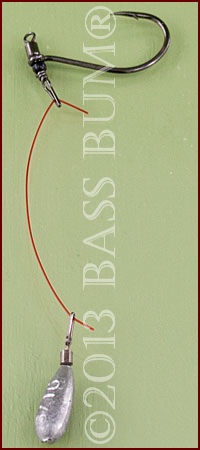 |
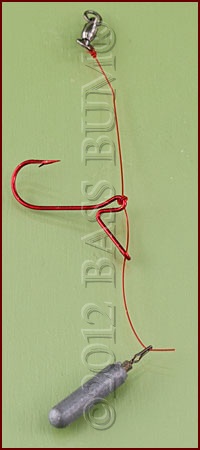 |
As you read on you will see that drop shot rigging offers you the opportunity to experiment with any number of hook styles, line types, drop shot weights and plastic drop shot baits.

How Do You Rig It?
Line - Hook -Sinker
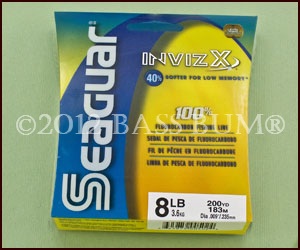
Line for a "traditional" drop-shot rig is 8lb or 10lb fluorocarbon. The hook is positioned on the line with a Palomar knot anywhere from 18-24" up from the sinker, which is placed on the very end of the tag line. If you're fishing deep water, say 20-30´ deep, the hook can be placed as much as 3-4´ up from the sinker.
There is no set rule about this distance. It can be as short as 6" or as long as 3-4´. With your depth finder determine the "active level" of the bass, that is, where they are holding, and set your hook distance accordingly. You want your lure at that level or above but never below that as bass most often feed up.
Line twist can be a particularly aggravating problem with a drop-shot rig. The "optional" use of a ball bearing swivel a few inches above the hook, (much twist comes from the bait) or between the hook and weight placed on the bottom end of the tag line will eliminate most of this. I choose to use a swivel or a a sinker with a built in swivel to eliminate twist. I hate line twist!
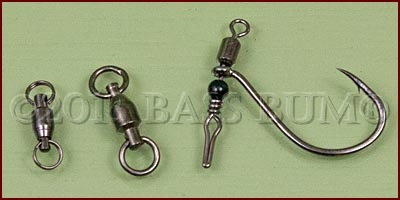
Recently I have used the new Gamakatsu Swivel-Shot hook (shown far right) with significant success. This little device has made rig set up easier and quicker for me.

Hooks for drop-shot rigs are numerous. A small no.2 Octopus-style hook on which a small 4" bait is nose hooked (as above) is the historical standard.
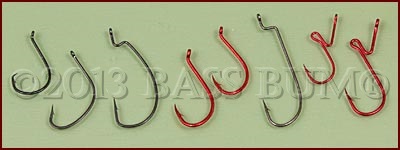
However, today's broadened application of the rig allows for the use of any number of hooks and baits. Basically, any light wire, open point, short shank, up-eye hook is good in open water. If fishing heavy cover or structure by flipping or pitching with larger lures then a regular worm hook is called for.
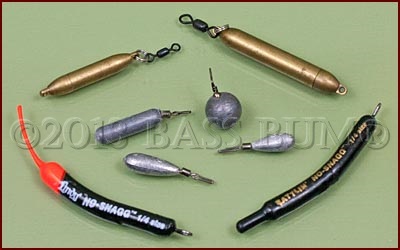
Sinker size varies based on cover, structure and water depth being fished. But in any event, drop shot weights should be sufficient to keep the rig squarely on the bottom allowing the rig to be lightly worked in place. For a vertical or horizontal (walking) presentation sinkers between 1/8 to 1/2 ounce size will work in most situations.
The black Lindy style elongated sinkers shown at right above have worked well for me when "walking" a rig. They're very snag resistant so hanging up is a rarity for me when I use them on a drop shot rig in the rock strewn bottoms of southern reservoirs.
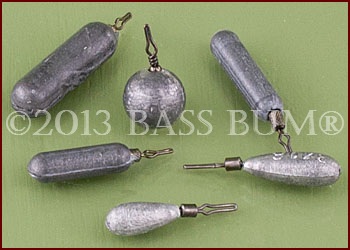
The sinkers pictured at right have built in swivels that help minimize line twist. The weight is merely "pressure clipped" on the line. This allows the sinker to pull off if you get hopelessly snagged while keeping the rest of the rig intact.
These are great but there are cheaper alternatives though they have their disadvantages. Some anglers will just use split shot but I can tell you this leads to severe line twist and hang ups. Some will tie on a slip sinker which is a royal pain in the butt if you get hung, break off and have to re-rig.

Drop-Shot Rig Hook Placement Is Very Important!
Correct placement of the hook on your line is of utmost importance. A Palomar knot is considered the gold standard for attaching the hook to line in a drop-shot rig. The steps involved in tying one are illustrated for your convenience.
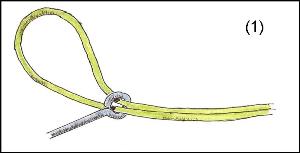
First, put a loop in your line and insert it through the "back side" of the hook eye. That's the side opposite the point. Be sure to leave a sufficiently long tag line on the end. This is where you will ultimately place your sinker.
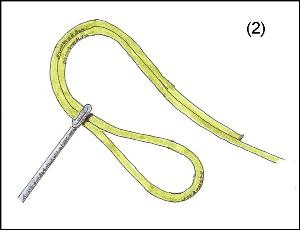
Next, bring the loop, with the hook hanging from it, back beside the standing line.
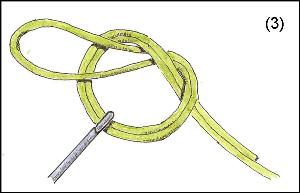
The third step is to make an overhand knot as shown.
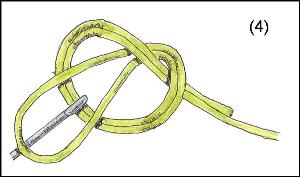
Fourth, pull the loop down far enough to pass it over the curved end of the hook.
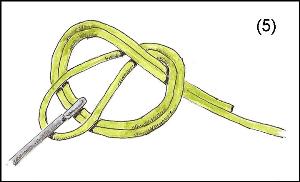
The fifth step requires your bringing the hook through the loop while holding the tag and standing ends together.
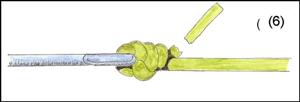
At this point, you would normally pull on the standing and tag ends of the line drawing them together into a knot. Then you would clip off excess tag as shown.
However, when creating a drop-shot rig "you must not" cut the tag but instead run the "long" tag line (18-24") through the hook point side of the hook eye. Why? This will cause the hook to stand out straight from the line with the hook point up after you affix the weight to the end of the line.

Drop-Shot Rig Variations
The drop-shot rig, originally developed as a finesse approach for fishing deep water or highly pressured waters, has evolved into a multi-faceted rig that can be fished in many different situations. The variations are limited only by your imagination.
I show the following few examples with a swivel, but remember, this is an "option" intended to minimize line twist, not a requirement for functionality. Remember also, that the swivel can be placed above the hook or between the hook and sinker.
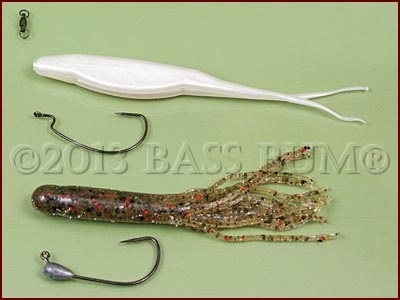
One "heavy duty" alternative is to use something like a fluke on an offset hook "up" the line and to use a weighted tube or jig instead of a sinker on the end of the line. Two depths can be covered with this targeting bass on the bottom as well as those holding above. Of course, an exposed hook on the bottom will increase the odds of hanging up if not rigged weedless.
Be aware that creating a drop-shot rig with a small #1 or #2 hook and small bait "up" on the line and a jig or tube on the bottom creates a problem relative to hook set. The former requires a quick "snap" set and simultaneous reeling while the later requires a heavy "jig bite" set. How do you know which bait was taken when you feel the strike? My suggestion, if you create a combo drop-shot rig make it either finesse or heavy duty. Don't mix the two.
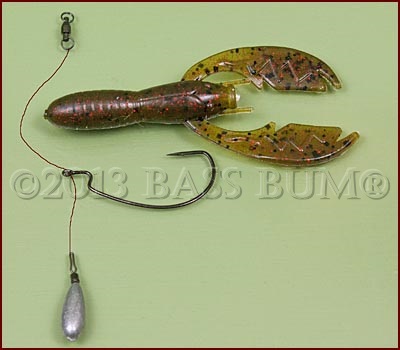
Another drop-shot rig alternative is one that is effective fishing weeds and grass as it suspends a craw or jig just under the mat, exactly where the bass are, instead of speeding it past them on the fall.
A 3/4 once jig could even be placed on the bottom of the tag instead of a sinker. You would be covering bass right under the mat as well as on the bottom.
Be sure to use a weight sufficient to punch through the surface mat of the weeds.
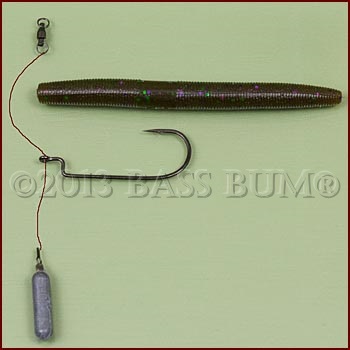
If fishing cover or structure a heavier hook and bait that is skin hooked is should be used. At right is a short Senko and a straight round bend worm hook for example. Any number of plastic baits could be used on such a set up.
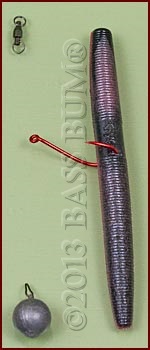
Combining a drop-shot rig and Wacky rig can prove very productive as the worm, especially a Senko type bait, has a very tempting action as it is gently jiggled in place.
This can also be modified by using a dropper line from the hook to the main line. As a matter of fact, it's a good way to fish shiners for smallmouth.
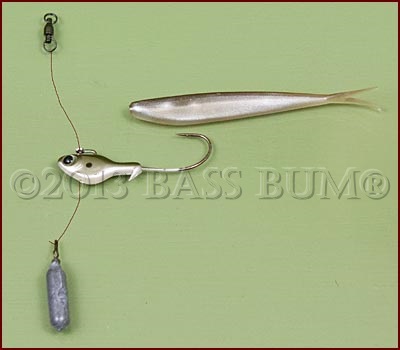
This is a nifty and effective drop-shot rig I have used with great success. The drop-shot fish head is from Swarming Hornet. I put a little 3" Zoom Tiny Fluke on it. It works great for paralleling bluffs.
Be certain to check your local fishing regulations concerning the use of multiple hooks on one line as they are not allowed in some areas.
Rod And Reel Selection For Drop-Shot Fishing
Rod and reel choice, as always, is a matter of personal preference. I use a couple of technique specific drop-shot rods for my finesse drop-shot presentation.
One is a G. Loomis, model DSR820S, 6´ 10" long, extra fast action rod for 4-8lb line. I combine this with a Quantum Energy PTi 30 spinning reel.
The other is an All Star model TAS 762S-DS, 6´ 4" long, extra-fast light action rod for 4-8lb line. I combine this with a Daiwa SS1300 spinning reel.
Any spinning rod that has a wispy tip (to impart action to bait), medium action and a bit of backbone in the middle and lower sections will work for a drop-shot rig. It should be rated for at least 12lb line if you intend to do some "heavy-duty" drop-shoting with full size baits and larger hooks. Casting rigs of the same ratings can also be used if that's your preference.
How Do You Fish A Drop-Shot Rig?
Return to Bass Fishing Rigs from Drop-Shot Rig
